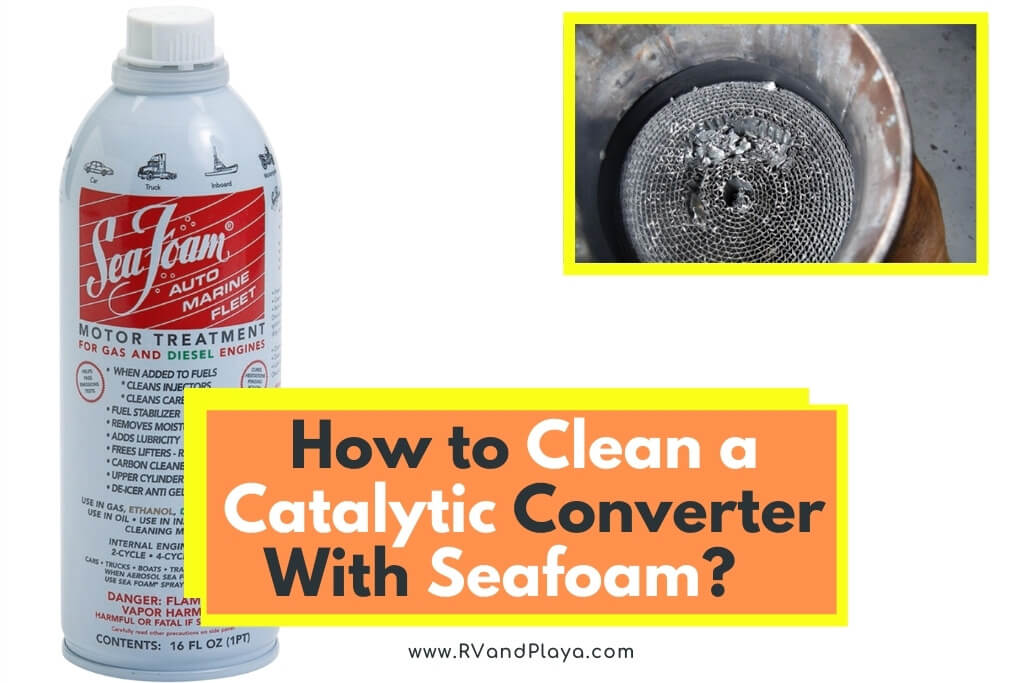Have you ever wondered how to clean a catalytic converter with seafoam? Well, look no more. We´ve got you covered.
Catalytic converters are your vehicle’s emissions control unit, converting harmful pollutants into safe gasses before they escape through the exhaust pipe. But for a catalytic converter to function properly, it has to stay clean.
When it comes to Seafoam, the most important thing to consider is the fact that it doesn’t clean your catalytic converter. What it does do is clean the engine and therefore acts as a preventative against a clogged and inefficient catalytic converter.
Seafoam, when used as a fuel additive, cleans and lubricates passageways throughout the engine, combustion chamber, intake valves, upper cylinders, and carburetors.
If these components are cleaned and maintained, problems with the catalytic converter are minimized.
So it’s not as if Seafoam is completely useless for cleaning your catalytic converter (cat). As a preventative, it works quite well, however, other means are necessary to properly clean a cat convertor.
Table of Contents
How To Use Seafoam As A Fuel Additive
It’s generally recommended to add Seafoam to your fuel once every 3,000 miles. To do it correctly, only add one ounce per gallon of gasoline for standard maintenance.
As a cleaner, you’ll want to increase the ratio to two ounces per gallon.
If you hear the 50/50 ratio bandied about, that’s not referring to mixing 50% Seafoam to 50% gasoline in your fuel tank. That ratio is only for cleaning machines designed to clean out the fuel injectors on diesel and gasoline engines.
The Seafoam additives work by eliminating build-up and deposits within various parts of the engine. Not only do they remove it, but the byproducts of that breakdown can safely pass through the cat converter without further burdening it by clogging it up.
If your cat converter reaches a point where black smoke is coming out of your tailpipe, you smell a “rotten egg” type of odor, or the bottom of your vehicle is increasingly hot, then it’s probably too late to take advantage of Seafoam and you’ll have to clean it with an alternative method.
PASS EMISSIONS WITH SEAFOAM!!! IT REALLY WORKS!!! >> Check out the video below:
How To Use Seafoam As An Oil Additive
You use Seafoam as an oil additive in the same way that you use it as a fuel additive, except that you drop one ounce into the oil crankcase per quart of oil.
You add it directly into the oil crankcase when you remove the cap and add oil during an oil change.
You’ll get the best results if you routinely add Seafoam during every oil change. It works by freeing up oil flow because it eliminates petroleum residues, cleans your actuators, and cleans deposits within the crankcase.
The better the engine runs, the better it’s able to burn out residue from the cat converter, avoiding deposit build-ups or not exacerbating existing deposits to the point that it clogs the cat up completely.
Are There Better Additives To Help Clean A Catalytic Converter Directly?
There are several brands of additives that are directly involved in cleaning the catalytic converter.
That doesn’t mean you should put Seafoam back up on the shelf, however. It’s still good as a companion to any one of these:
- Cataclean by Mr. Gasket: Removes carbon build-up within the cat convertor and eliminates deposits in the fuel injectors and carburetor.
- Hi-Gear Catalytic Converter Cleaner: Fuel additive that cleans up carbon deposits in the cat converter.
- Chevron Techron Complete Fuel System Cleaner: Acts in a similar fashion as Seafoam, but does have a cleaning effect on the cat converter by removing deposits.
- Oxicat: Oxicat goes after your cat converter directly and cleans your O2 sensors as well. It’s also useful in hybrid vehicles.
Seafoam, when combined with any of the above, is the perfect engine (pun intended) for cleaning your entire system by getting rid of the byproducts and deposits formulated from combustion.
While Seafoam alone won’t clean your catalytic converter, it’s an additive that works well in combination with others.
Eliminating the accumulated deposits that can find their way into your converter is just as important as cleaning what’s in your cat converter.
Seafoam Will Destroy A Catalytic Converter That’s On Its Last Legs
While Seafoam is an outstanding product and works very well when it comes to cleaning your engine’s moving parts, it is not recommended to use it when your cat converter is having problems due to clogging.
What Seafoam does, it does well. Unfortunately, that well-done job could also spell doom for a catalytic converter that’s in desperate need of a cleaning.
Since Seafoam removes deposits and build-up within your engine’s moving parts and removes it via the exhaust, an already clogged cat converter is liable to completely clog.
When this happens, you might as well call it a day and replace your catalytic converter, because it’s a whole lot cheaper than an entire engine overhaul.
As the cat converter becomes more and more clogged, your engine and fuel economy will suffer as well.
Using Seafoam as a last-ditch effort to clean a cat converter will only compound the problem. With the cat clogged, less airflow will reach the engine, depriving combustion of one of the three elements it needs, air.
Since the engine is working harder, your fuel economy will suffer as the engine gobbles up more fuel.
You’ll experience misfires, jumpy acceleration, horrific fuel economy, and it’ll probably smell like garbage, embarrassing you at every red light.
Ultimately, if you’re going to use Seafoam, it’s best to do so with a clean catalytic converter. Also, you can always avoid using other additives to clean your cat converter and just physically clean it.
Read also: Does Seafoam Damage o2 Sensors? (SAFE)
How To Clean Your Catalytic Converter
Sure, it has a funny name and sounds like something that only a certified mechanic should bother with but it’s not too difficult to remove and clean your cat converter. The first thing to do is locate it.
The catalytic converter is located between the exhaust and the engine, beneath the vehicle.
You can find it by tracing the exhaust from the back of the vehicle till you reach the large “lump” usually centered along the length of the car.
It’s usually bolted to the manifold and can be removed by taking the bolts and brackets holding it on. It’s best to have the vehicle on a lift or up on ramps, emergency brake on, in first gear or park, and the tires properly wedged in place.
- Mix dish soap and water in a bucket
- Put the cat converter in the bucket, completely submerged for an hour and a half
- Remove it and rinse it once the hour and a half is up
- Let it dry completely.
- Remount it under the vehicle
You shouldn’t spend any time scrubbing and avoid using harsh abrasives or wire brushes to clean the cat converter.
The converter works by chemically altering the smog produced as a byproduct of combustion and if you scrub it, you may reduce its ability to do that.
Catalytic converters are expensive because of the precious metals used in their fabrication. Those precious metals are not very durable and it is highly inadvisable to go at it with an abrasive of any kind.
How To CLEAN A Catalytic Converter >> Check out the video below:
Can You Get Rid Of A Catalytic Converter?
The days of the roaring, bulky, American muscle car are over and, despite the irritation that a catalytic converter may give you, it is prohibited by many states to remove a cat converter from your vehicle.
You’ll also need to follow current EPA guidelines as well as the EPA 1986 Catalyst Policy. Removing a catalytic converter comes with certain pros and cons as well.
Pros
- You’ll have a cool sounding exhaust
- Better gas mileage
- More fuel options
- More horsepower
Cons
- Possible violation of State laws
- Increase in CO² emissions
- It’ll fail emissions inspections
- Loss of low-end torque
In other words, be careful if you plan on removing a catalytic converter. There are just as many disadvantages as advantages and it won’t go over well if it’s prohibited by State law.
Replacing a catalytic converter is expensive and instead of removing it, you may have to consider just getting a new vehicle.
Thanks to federal law, even a brand new cat converter that survived an accident and now resides in a scrap yard, you can’t replace it with a used one.
All Things Considered
Just because Seafoam doesn’t work to clean a catalytic converter directly, does not mean that it has no indirect value that benefits your cat.
Seafoam is still an excellent cleaning additive, whether it’s used in fuel, oil, or as a fuel storage maintainer.
There’s no reason not to trust Seafoam to help maintain your vehicle by cleaning and lubricating the moving parts of your engine and, as a healthy side-effect, relieving the burden on your catalytic converter.
Here are some of my favorite tools & equipment´s
Thank you for reading this article. I hope it helps you find the most recent and accurate technical and repair information for your car. Here are some tools that I use as an automotive technician and hope you´ll also find helpful.
There are affiliate links, so if you do decide to use any of them, I´ll earn a small commission. But in all honesty, these are the exact tools that I use and recommend to everyone, even my own family. (NO CRAP)
To see all my of most up-to-date recommendations, check out this resource that I made for you!
References
Recent Posts
Your catalytic converter is a huge part of your vehicle’s exhaust system. When working properly, the catalytic converter treats all of the exhaust gases released from the engine to remove any...
Have you ever wondered if seafoam could damage o2 sensors? Your car is very likely one of your most costly investments. Owning, operating, and maintaining a motor vehicle is expensive. You...


